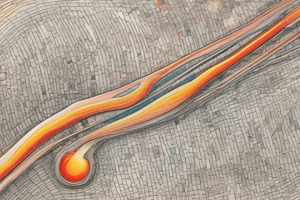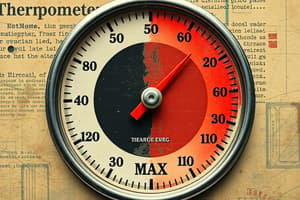Podcast
Questions and Answers
What is the relationship between the coefficients of thermal expansion β, α, and γ?
What is the relationship between the coefficients of thermal expansion β, α, and γ?
- α = β/2 = γ/3 (correct)
- α = 2β = 3γ
- α = γ/2 = β/3
- α = β/3 = γ/2
The specific heat at constant pressure is less than that at constant volume.
The specific heat at constant pressure is less than that at constant volume.
False (B)
What is sublimation?
What is sublimation?
The change from solid state to vapor state without passing through the liquid state.
Thermal expansion is utilized in __________ for temperature measurement.
Thermal expansion is utilized in __________ for temperature measurement.
Match the application of thermal expansion with its description:
Match the application of thermal expansion with its description:
Why do we consider two specific heats of a gas?
Why do we consider two specific heats of a gas?
Freezing point and melting point occur at different temperatures.
Freezing point and melting point occur at different temperatures.
What happens to a steel wheel when heated before fitting onto an axle?
What happens to a steel wheel when heated before fitting onto an axle?
What is the cumulative measurement of heat in a system referred to as?
What is the cumulative measurement of heat in a system referred to as?
Thermal conductivity is independent of temperature.
Thermal conductivity is independent of temperature.
What is absolute zero in Celsius?
What is absolute zero in Celsius?
The SI unit of heat is the ______.
The SI unit of heat is the ______.
Match the coefficient of thermal expansion to its property:
Match the coefficient of thermal expansion to its property:
Which of the following accurately describes the relation between the Celsius and Fahrenheit scales?
Which of the following accurately describes the relation between the Celsius and Fahrenheit scales?
Heat is the same as temperature.
Heat is the same as temperature.
What is the primary use of a calorimeter?
What is the primary use of a calorimeter?
What is the unique condition called when all three states of matter coexist in equilibrium?
What is the unique condition called when all three states of matter coexist in equilibrium?
In steady state condition, the temperature of every section of a rod remains variable over time.
In steady state condition, the temperature of every section of a rod remains variable over time.
What does the coefficient of thermal conductivity represent?
What does the coefficient of thermal conductivity represent?
The _____ of a body is its opposition to the flow of heat through it.
The _____ of a body is its opposition to the flow of heat through it.
Match the following applications of thermal conductivity with their descriptions:
Match the following applications of thermal conductivity with their descriptions:
Which factor does NOT affect the quantity of heat flowing in thermal conductivity?
Which factor does NOT affect the quantity of heat flowing in thermal conductivity?
Thermal conductivity is only dependent on the temperature difference between two faces.
Thermal conductivity is only dependent on the temperature difference between two faces.
Define the term 'steady state' in the context of heat conduction.
Define the term 'steady state' in the context of heat conduction.
Flashcards
Thermal Expansion Coefficient (α)
Thermal Expansion Coefficient (α)
A material's change in length or volume per unit length or volume per degree Celsius of temperature change.
Relationship between α, β, and γ
Relationship between α, β, and γ
How linear, surface, and volumetric expansion coefficients are related; α = β/2 = γ/3
Application of Thermal Expansion: Thermometers
Application of Thermal Expansion: Thermometers
Thermometers use thermal expansion of liquids (like mercury) to measure temperature.
Application of Thermal Expansion: Tight Lids
Application of Thermal Expansion: Tight Lids
Signup and view all the flashcards
Specific Heat at Constant Pressure (Cp)
Specific Heat at Constant Pressure (Cp)
Signup and view all the flashcards
Specific Heat at Constant Volume (Cv)
Specific Heat at Constant Volume (Cv)
Signup and view all the flashcards
Freezing Point/Melting Point
Freezing Point/Melting Point
Signup and view all the flashcards
Sublimation
Sublimation
Signup and view all the flashcards
Triple point
Triple point
Signup and view all the flashcards
Steady state
Steady state
Signup and view all the flashcards
Coefficient of thermal conductivity
Coefficient of thermal conductivity
Signup and view all the flashcards
Thermal resistance
Thermal resistance
Signup and view all the flashcards
What happens to a metal rod when one end is heated?
What happens to a metal rod when one end is heated?
Signup and view all the flashcards
What's the difference between the temperature of a rod in a steady state and a variable state?
What's the difference between the temperature of a rod in a steady state and a variable state?
Signup and view all the flashcards
Why are cooking utensils provided with handles of bad conductors?
Why are cooking utensils provided with handles of bad conductors?
Signup and view all the flashcards
Why do we use thick walls containing bricks in cold storage rooms?
Why do we use thick walls containing bricks in cold storage rooms?
Signup and view all the flashcards
Heat vs. Temperature
Heat vs. Temperature
Signup and view all the flashcards
SI Units of Heat and Temperature
SI Units of Heat and Temperature
Signup and view all the flashcards
Dimensions of Heat and Temperature
Dimensions of Heat and Temperature
Signup and view all the flashcards
How is a Thermometer Calibrated?
How is a Thermometer Calibrated?
Signup and view all the flashcards
Temperature Scales
Temperature Scales
Signup and view all the flashcards
Celsius and Fahrenheit Relationship
Celsius and Fahrenheit Relationship
Signup and view all the flashcards
Absolute Zero
Absolute Zero
Signup and view all the flashcards
Relation Between Thermal Expansion Coefficients
Relation Between Thermal Expansion Coefficients
Signup and view all the flashcards
Study Notes
Thermal Properties of Matter
- Heat vs. Temperature:
- Heat is a form of energy transferred between a system and its surroundings due to temperature difference.
- Temperature measures the degree of hotness of an object.
- SI unit of heat is Joule (J).
- SI unit of temperature is Kelvin (K) or Celsius (°C).
- Dimensions of heat are [L²M¹T⁻²].
- Dimensions of temperature are [L⁰M⁰T⁰Θ¹].
- Heat is measured using a calorimeter.
- Temperature is measured using a thermometer.
Thermometer Calibration
- Standard temperature intervals are selected for calibration.
- These intervals are easily reproducible.
- The interval is then subdivided into degree intervals.
- Numerical values are assigned to each interval/degree.
Scales of Temperature
- Temperature scales include Celsius, Fahrenheit.
- Relationships exist between these scales.
- (TF - 32) / 180 = (Tc - 0) / 100
Absolute Zero
- Absolute zero is the temperature at which a gas's pressure would be zero.
- Absolute zero is -273.15 °C.
Thermal Expansion Coefficients
- Relationships exist between coefficients of linear, surface, and volume expansion.
- Linear expansion: 𝐿 = 𝐿₀ (1 + α𝑡) (Where L₀ is the initial length and α is the coefficient of linear expansion)
- Surface expansion: 𝐴 = 𝐴₀ (1 + 2 α𝑡) (Where A₀ is the initial surface area)
- Volume expansion: V = V₀ (1 + 3 α𝑡) (Where V₀ is the initial volume)
Applications of Thermal Expansion
- Thermometers: Expansion of liquids (like mercury) measures temperature.
- Removing tight lids: Heating expands the metal cap, making it easier to open.
- Fitting steel wheels on axles: Expanding the wheel and cooling it locks it securely in place.
Specific Heats of Gases
- Two specific heats are considered for gases: at constant pressure (Cp) and constant volume (Cv).
- Cp is greater than Cv.
- This is because at constant pressure, gas does work on surroundings requiring additional heat.
Freezing and Melting Points
- Freezing point and melting point are the same temperature.
- Freezing point is when liquid becomes solid.
- Melting point is when solid becomes liquid.
Sublimation
- Sublimation is the change from solid to vapor state without passing through the liquid state.
Steady State
- Steady state refers to a condition where the temperature of each part of an object (like a metal rod) does not change with time, even as heat continues to flow.
- A rod's temperature is constant at each point across it but not the same across the length of the rod.
Thermal Conductivity
- Thermal conductivity is the rate of heat conduction through a material.
- It is dependent on the distance between the two areas, the area itself, the time, and the temperature difference.
- Mathematically, Q = (K * A * (T₁-T₂)*t) / x (where Q is the rate of heat transfer, k is thermal conductivity, A is area, T₁ and T₂ are the temperatures, t is time, and x is distance).
Applications of Thermal Conductivity
- Cooking utensils are often made of metals (good conductors) but have handles of poor conductors to protect from burns.
- Ice does not melt easily in sawdust, as sawdust is a poor conductor preventing rapid heat conduction to the ice.
- Electric irons have mica coatings: good conductors of heat, but bad conductors of electricity to protect from shocks.
Thermal Resistance
- Thermal resistance is the opposition of a substance to heat flow.
- RT = x / (K * A).
Heat Transfer via Radiation
- Heat can be transferred through radiation without a medium (e.g., from the sun).
Newton's Law of Cooling
- The rate of heat loss is proportional to the difference in temperature between the object and its surroundings, if the temperature difference is small.
Thermal Stress
- Thermal stress arises when material expansion is restricted.
- Gaps are left in structures (like bridges and roads in hot climates) to prevent thermal stress damage.
Thermal Insulators
- Materials with high thermal resistance are poor conductors and good insulators (e.g., glass, wood, rubber, plastic).
Studying That Suits You
Use AI to generate personalized quizzes and flashcards to suit your learning preferences.




